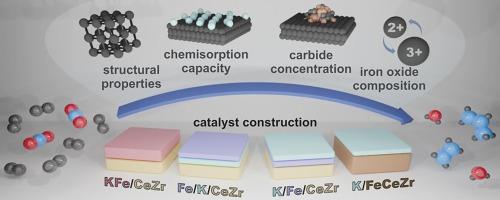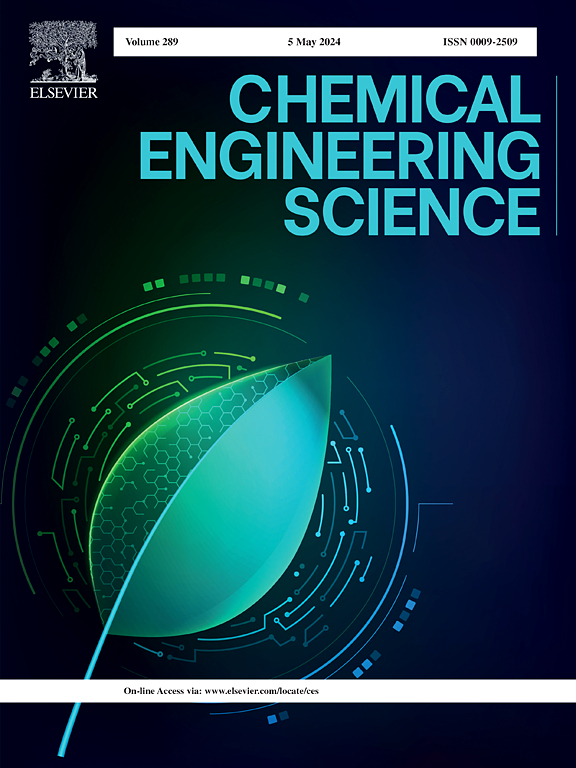Impact of the K and Fe insertion methods in KFeCeZr catalysts on the CO2 hydrogenation to C2/C3 olefins at room pressure
IF 4.1
2区 工程技术
Q2 ENGINEERING, CHEMICAL
引用次数: 0
Abstract
Light olefins, traditionally sourced from petroleum, are currently being investigated through alternative routes, such as CO2 hydrogenation, aligning with CCUS policies. Alkali-promoted Fe-based catalysts have shown promise in coupling reverse water–gas shift and Fischer-Tropsch processes to produce light olefins from CO2 directly. The in-situ generated Fe5C2 phase is commonly associated with the high activity of these catalysts. However, the preparation methods employed can lead to distinct catalyst properties, which considerably impact the performance during the reaction. Here, we investigate different strategies to introduce K and Fe in the KFeCeZr system and correlate catalyst properties with catalytic activity during CO2 hydrogenation at ambient pressure. The catalyst prepared by one-pot precipitation of Fe, Ce, and Zr followed by K impregnation showed the most promising results in terms of conversion and productivity of light olefins. The effective incorporation of Fe in the CeZrOx structure during synthesis was essential for maintaining the high dispersion of metallic Fe particles after reduction, improving reactant chemisorption. Under reaction conditions, this catalyst showed the most remarkable propensity to form iron carbides (FexCy), mainly composed of Fe5C2 phase. In general, this work highlights the impact that the construction steps of a multifunctional catalyst have on the physicochemical properties and, consequently, on the catalytic activity.

KFeCeZr 催化剂中的 K 和 Fe 插入方法对常压下 CO2 加氢制 C2/C3 烯烃的影响
轻质烯烃传统上来自石油,目前正在通过二氧化碳加氢等替代途径进行研究,以符合 CCUS 政策。碱促进的铁基催化剂在耦合反向水-气变换和费托工艺以直接从二氧化碳生产轻烯烃方面显示出前景。原位生成的 Fe5C2 相通常与这些催化剂的高活性有关。然而,所采用的制备方法会导致催化剂性质的不同,从而对反应过程中的性能产生很大影响。在此,我们研究了在 KFeCeZr 体系中引入 K 和 Fe 的不同策略,并将催化剂特性与常压下 CO2 加氢反应的催化活性联系起来。在轻质烯烃的转化率和生产率方面,通过一次沉淀 Fe、Ce 和 Zr 并浸渍 K 制备的催化剂显示出最有前途的结果。在合成过程中将 Fe 有效地加入 CeZrOx 结构中对于还原后保持金属 Fe 颗粒的高度分散、改善反应物的化学吸附至关重要。在反应条件下,这种催化剂表现出最显著的形成碳化铁(FexCy)的倾向,主要由 Fe5C2 相组成。总之,这项工作强调了多功能催化剂的构建步骤对其物理化学特性的影响,以及由此对催化活性的影响。
本文章由计算机程序翻译,如有差异,请以英文原文为准。
求助全文
约1分钟内获得全文
求助全文
来源期刊

Chemical Engineering Science
工程技术-工程:化工
CiteScore
7.50
自引率
8.50%
发文量
1025
审稿时长
50 days
期刊介绍:
Chemical engineering enables the transformation of natural resources and energy into useful products for society. It draws on and applies natural sciences, mathematics and economics, and has developed fundamental engineering science that underpins the discipline.
Chemical Engineering Science (CES) has been publishing papers on the fundamentals of chemical engineering since 1951. CES is the platform where the most significant advances in the discipline have ever since been published. Chemical Engineering Science has accompanied and sustained chemical engineering through its development into the vibrant and broad scientific discipline it is today.
 求助内容:
求助内容: 应助结果提醒方式:
应助结果提醒方式:


